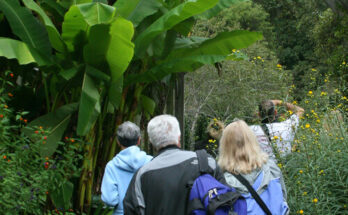Plenty of wonderful shrubs and small trees make for amazing garden attractions, but not many can beat the Rose of Sharon (Hibiscus syriacus). When most of your garden has called it a day, this wonderful plant is just starting.
Sometimes referred to as a shrub althea, it produces a plethora of 5-petaled trumpet-shaped flowers that measure 3″ to 5″ inches across and come in many colors and single or double-petal varieties.
However, one common problem with this plant is the habit of being covered with blooms one year and failing to bloom in another. Here’s all you need to know about when to expect blooms and what to do if they’re not coming up on schedule.
What Is The Blooming Time Of Rose of Sharon Plants?
The answer varies slightly between cultivars and the USDA hardiness zone you live in. However, a healthy plant should produce blooms in July and August regardless of these factors.
Typical Bloom Time For Rose Of Sharon
Rose of Sharon is a late bloomer and one of the latest popular shrubs.
Depending on how far south you are, the blooms may first appear as early as June, but you won’t see the flowers until July. However, in July, you will see the flowers for most of the compatible USDA hardiness zones.
Likewise, the blooms will continue for longer in the earnest climates, with most zones lasting through September and warmer ones sometimes lasting into October.
This is because the blooms are temperature sensitive, and the tree will start hibernating once cold weather hits, causing it to stop blooming to conserve energy.
Why A Rose Of Sharon Might Fail To Bloom?
Sometimes, your rose of Sharon will refuse to bloom. Depending on the circumstances, the shrub may develop buds that never fully develop or might not bud at all.
There are many potential reasons for this, but they’re generally minor and easy to address.
Unfortunately, these problems might not bloom until the following year unless you catch them before it’s time to bloom.
Here are the most common causes of blooming issues and how to solve them.
Disease And Infestations
Rose of Sharon isn’t particularly vulnerable, with aphids and hibiscus whiteflies being the most common pests.
Aphids won’t do much damage, but their honeydew can lead to fungal infections.
In fact, fungal infections are a common issue with this plant if the leaves are allowed to remain wet.
The other big disease risk is root rot, another moisture-related disease.
Improper Watering
Speaking of moisture, overwatering is a huge issue.
Avoid overhead watering, as this can result in the leaves not drying out properly, so never leave the soil soggy. This can lead to root rot and several different fungal infections.
On the flip side, insufficient water will affect the plant’s ability to produce blooms and can cause other issues.
The soak-and-dry method works really well for this plant and can help ensure it’s never overwatered or underwatered.
You’ll need to check the moisture level 6” inches down, so you’ll need to use the stick method.
This means taking a chopstick or long popsicle stick, marking it at the 6” inch mark, then sticking it straight down into the soil to that depth.
Leave it for 20 minutes before pulling the stick back out. The stick will be darker where there’s moisture present.
If the stick comes out dry, it’s time to water. Add the water slowly and evenly, working your way around the base of the plant until the ground begins having trouble absorbing at the same rate you’re watering it.
Nutrient Deficiency
Plants need a variety of nutrients to survive. These include everything from Nitrogen to manganese.
However, phosphorus is one of the most important nutrients needed for the flowering process.
A little phosphorus goes a long way, and you can easily amend the soil with a bit of bone meal if the soil is deficient.
Likewise, fertilizing the plant can also help restore the phosphorus content.
However, giving your shrub too much fertilizer will actually stunt its growth, so you will want to test the soil if you aren’t sure whether or not this is an issue.
Poor Lighting
This particular shrub requires full sun to bloom properly, and inadequate lighting can often prevent blooms from fully developing.
For healthy blooms, your rose of Sharon needs at least 6 hours of full sunlight per day.
When the shrub isn’t getting enough sunlight, it can’t photosynthesize properly.
As a result, the plant will focus on producing more foliage instead of investing its energy into creating blooms.
Poor Pruning Habits
This is a very common culprit. Like many other shrubs and trees, the Rose of Sharon will only bloom on new growth.
Therefore, while you can technically prune your plant at any point in the growing season, pruning away new growth may reduce the number of blooms or eliminate them entirely.
There are three times when you can prune your rose of Sharon without the risk of preventing blooms.
- One of the safest times to prune your plant is right after the blooming phase ends.
- The second safest time is early spring before you see any new growth.
- A third option is a little riskier but worth it if you get the timing right – removing some of the bud’s growth early on. This method can be tricky and isn’t recommended for anyone unsure of themselves.
However, removing some of the new buds will generally cause larger blooms at the cost of quantity.
Source link
Originally posted 2022-11-23 20:41:36.





